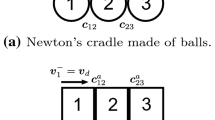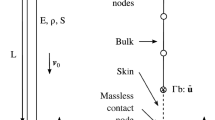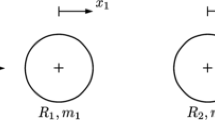Abstract
Painlevé's paradox is one of the basic difficulties for solving LCP of dynamic systems subjected to unilateral constraints. A bi-nonlinear parameterized impact model, consistent with dynamic principles and experimental results, is established on the localized and quasi-static impact model theory. Numerical simulations are carried out on the dynamic motion of Painlevé's example. The results confirm “impact without collision” in the inconsistent states of the system. A “ritical normal force” which brings an important effect on the future movement of the system in the indeterminate states is found. After the motion pattern for the impact process is obtained from numerical, results, a rule of the velocity's jump that incorporates the tangential impact process is deduced by using an approximate impulse theory and the coefficient of restitution defined by Stronge. The results of the jump rule are quite precise if the system rigidity is big enough.
Similar content being viewed by others
References
Pfeiffer F, Glocker CH. Unilateral Multibody Contact. Netherlands: Kluwer Academic Publishers, 1998
Pfeiffer F, Glocker CH. Multibody Dynamics with Unilateral Contacts. New York: Wiley and Sons, 1999
Brogliato B. Nonsmooth Mechanics, Models, Dynamics and Control. London: Springer-Verlag London Limited, 1999
Tzitzouris JA. Numerical resolution of frictional multirigid-body system via fully implicit time-stepping and nonlinear complementarity. [Ph D Thesis]. Baltimore, Maryland: Hopkins University, 2001
Wang Y, Mason MT. Two-dimensional rigid-body collisions with friction,ASME J Appl Mech, 1992, 59: 635–642
Song P, Kraus P, Kumar V, Dupint P. Analysis of rigid-body dynamic models for simulation of systems with frictional contacts.ASME J Appl Mech, 2001, 68: 118–128
Chen B, Yan ZX, Zhao Z. The impact model resolution of Kane dynamic puzzle.Acta Mechanica Sinica, 2002, 34 (Supplement): 43–47 (in Chinese)
Johnson KL. Contact Mechanics. New York: Cambridge University Press, 1985
Vu-Quoc L, Zhang X, Lesburg L. A normal force-displacement model for contacting spheres accounting for plastic deformation: force-driven formulation.ASME J Appl Mech, 2000, 67: 363–371
Liu CS, Chen B. A normal force-displacement model for impacting rigid body accounting for elastic-plastic deformation.Acta Mechanica Sinica, 2002, 34 (Supplement): 57–60 (in Chinese)
Shivaswamy S. Modeling contact forces and energy dissipation during impact in mechanical systems. [Ph D Thesis]. Ann Arbor MI: UMI, 2002
Poston T, Stewart I. Catastrophe Theory and Its Applications, London: Pitman Publishing Limited, 1978
Author information
Authors and Affiliations
Additional information
The project supported by the National Natural Science Foundation of China (10272002), Doctoral Foundation of Educational Ministry of China (20020001032) and the foundation (024132009203235)
Rights and permissions
About this article
Cite this article
Zhen, Z., Bin, C., Caishan, L. et al. Impact model resolution on Painlevé's paradox. Acta Mech Sinica 20, 649–660 (2004). https://doi.org/10.1007/BF02485869
Received:
Revised:
Issue Date:
DOI: https://doi.org/10.1007/BF02485869




